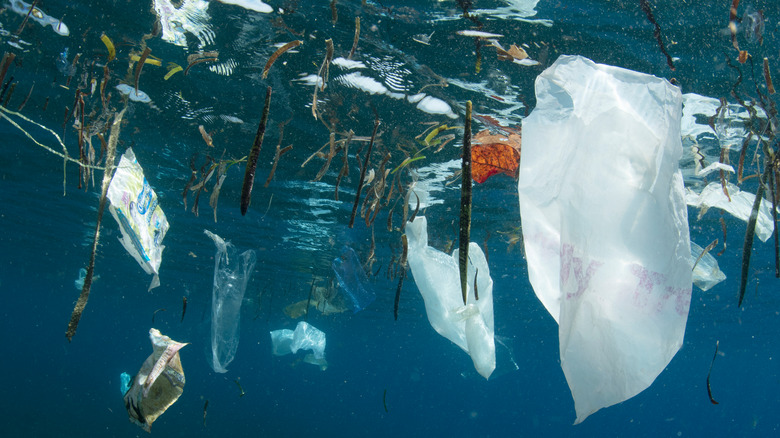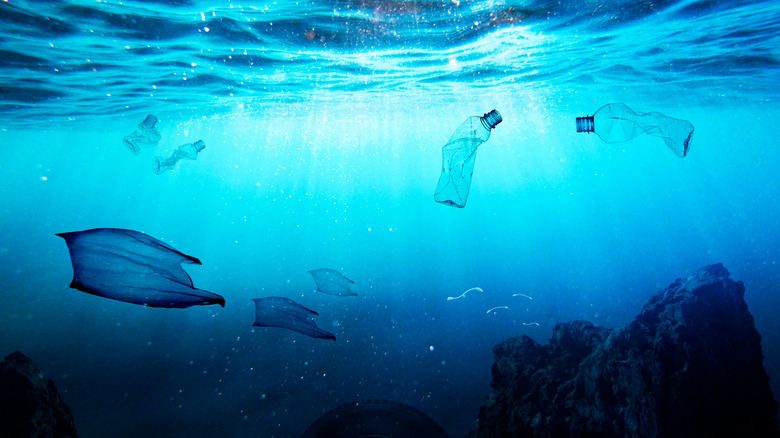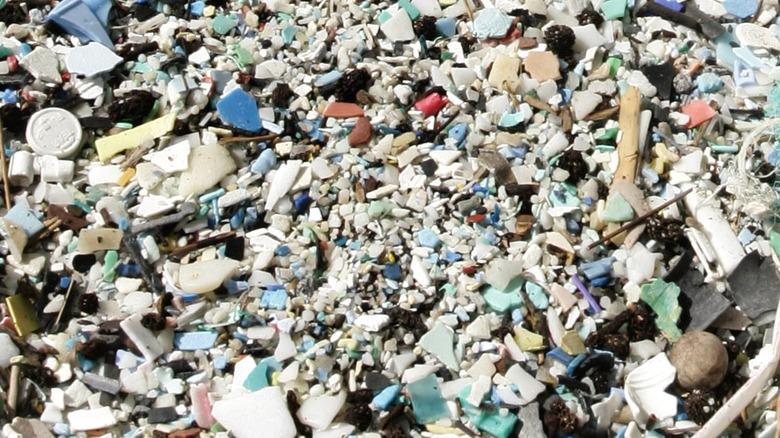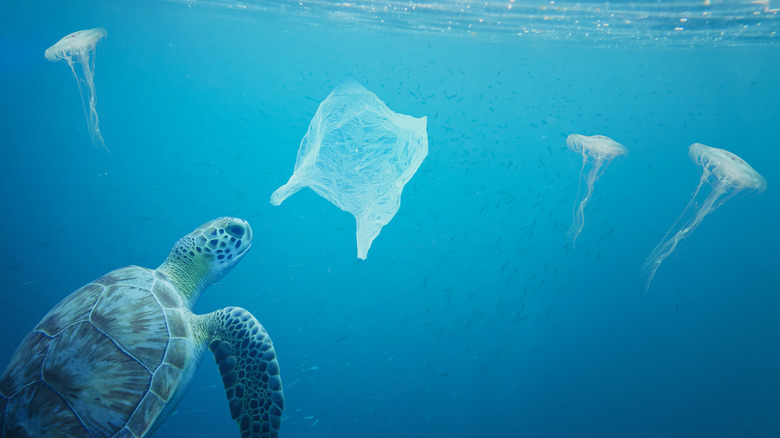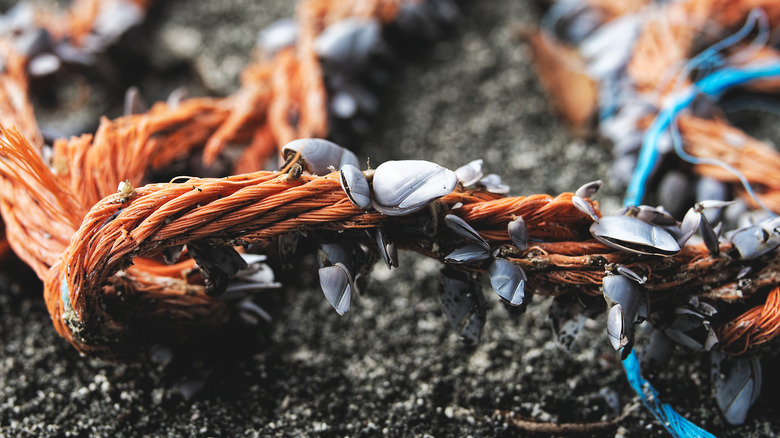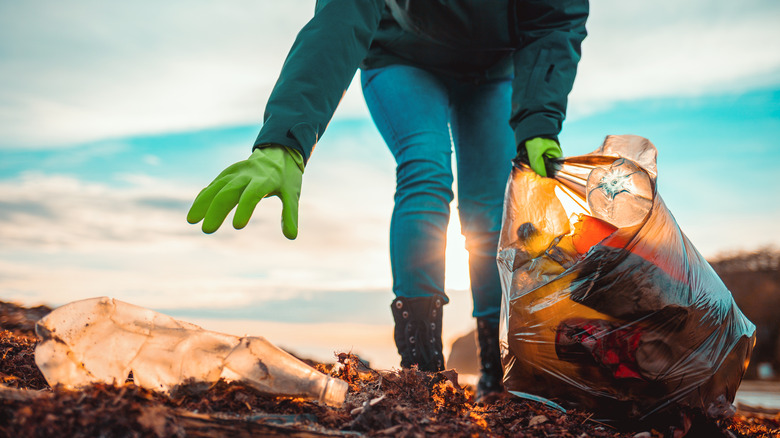The Truth About The Pollution Making Up The Great Pacific Garbage Patch
Captain Charles Moore was returning home from a yachting race in 1997. During the trip from Hawaii to California, he and his crew used a route through an exceptionally calm part of the Pacific Ocean. He told Earth Island Journal that he started to notice small bits and traces of trash and debris — all signs of human civilization — in the ordinarily pristine ocean. "It seemed unbelievable," he said to Natural History magazine in 2003 (via National Geographic). "I never found a clear spot. In the week it took to cross the subtropical high, no matter what time of day I looked, plastic debris was floating everywhere: bottles, bottle caps, wrappers, fragments."
Capitan Moore had stumbled upon what some now call the "Great Pacific Garbage Patch" and others know as the "Pacific Trash Vortex." No matter its name, the enormous clusters of plastic debris floating in the Pacific Ocean are agreed-upon threats to marine life and contributors to climate change. However, finding consensus around efforts to fix the problem is less straightforward. Worse, new information about coastal marine life surviving and thriving in the middle of the ocean on pieces of trash poses significant questions about the increasingly dangerous repercussions of the ever-growing Pacific Trash Vortex.
Where is the Great Pacific Garbage Patch?
A staggering 14 million tons of plastic enter the world's oceans each year, reports Smithsonian Magazine. Garbage dumped into the Pacific Ocean or its tributaries become pulled by powerful swirling circular currents known as a gyre. After the gyre draws in the trash, the garbage settles and collects in the gyre's calm-watered center, writes National Geographic. The world's oceans have five gyres, each with its own trash-filled centers. The garbage patch in the Pacific Ocean happens to be the largest, says Smithsonian Magazine.
The Great Pacific Garbage Patch is about twice the size of Texas, and it is estimated to be 79,000 metric tons of debris (via Smithsonian Magazine). All of that litter rests within the North Pacific Subtropical Gyre, comprised of two different clusters. The Western Garbage Patch sits closer to Japan, while the Eastern Garbage Patch lies between Hawaii and California. These two clusters are connected by the convergence of warm South Pacific water and cool Arctic water, creating movement between the two patches.
National Geographic equates this convergence, called the North Pacific Subtropical Convergence Zone, to a highway that carries debris from one garbage cluster to another. As the garbage and debris move through the currents, it breaks down into smaller pieces. These are known as microplastics, which are deadly for marine life and humans alike.
What is the Pacific Trash Vortex made of?
When people think of the Great Pacific Garbage Patch, they might envision garbage and detritus woven into an island-like trash heap. Instead, murky water filled with microplastics and the occasional patches of larger debris makes up the Pacific Trash Vortex. This sea of small plastics is what Charles Moore encountered in 1997. He described it to Natural History magazine (via National Geographic): "As I gazed from the deck at the surface of what ought to have been a pristine ocean, I was confronted, as far as the eye could see, with the sight of plastic."
What the Great Pacific Garbage Patch looks like underneath the surface is still a mystery. But scientists discovered that 70% of garbage in the ocean sinks to the seafloor (per National Geographic). Most likely, the Great Pacific Garbage Patch is the tip of the trash iceberg. However, there's still much to learn about the plastic and waste beneath the ocean's surface.
According to the World Economic Forum, if we don't stop our current use of plastic and curb the flow of plastic into the world's oceans, the Earth's waters will hold more plastic than fish by 2050 (via Reuters).
Plastic in the ocean has deadly consequences
The Great Pacific Garbage Patch's plastic, large and small, poses a threat to marine life and humans. Microplastics are devastating to every part of the marine food web, from plankton to apex predators. Plankton and algae are a base food for marine life; they feed many animals whose nutrients work up the food chain. When microplastics cloud the ocean's surface, they block the sunlight needed for plankton and algae to grow. This deprives many animals of the necessary nutrients to nourish the food chain (via National Geographic). Sadly, some birds mistake microplastics for fish eggs and feed the plastic to their young, unintentionally killing them through starvation or ruptured organs.
Larger plastic pieces are no less deadly. Sea turtles mistake plastic bags for jellyfish and die from trying to eat them, while seals and other large-sized sea life get tangled in discarded fishnets and perish, unable to escape. But perhaps the most significant threat from the Pacific Trash Vortex is unseen: Pollutants and harmful chemicals leaching out of the discarded plastics, such as bisphenol A (BPA), are linked to several health issues in adults and children (via National Geographic). Worse, plastic absorbs harmful chemicals like polychlorinated biphenyls (PCBs), which are linked to cancer, says the United States Environmental Protection Agency. Once PCB-carrying plastics are consumed by marine life, they enter the food chain and work their way up to large mammals, including humans.
New Concerns: Coastal marine life thrives in the middle of the ocean
There are new questions about how the Great Pacific Garbage patch will affect ocean ecosystems. In 2021, a study published in Nature Communications found that coastal marine life like crustaceans, barnacles, and sea stars are thriving in the middle of the ocean, which is typically uninhabitable for them (via Smithsonian Magazine). Usually, they require the protection of a coastline. "It's almost like a new island has emerged," says Greg Ruiz, a Smithsonian Environmental Research Center scientist.
Since the Pacific Trash Vortex is associated with danger for sea life, the thought of new species thriving in the middle of the ocean may seem like a good thing. Still, questions arise about what will happen when the new coastal species compete for food and resources with the native inhabitants of the area. "There are so many questions at this point about what the ecological impacts are," says Linsey Haram, a research associate at the Smithsonian Environmental Research Center and co-author of the study (via Smithsonian Magazine).
Solutions for the many issues caused by Pacific Trash Vortex remain complex. Frustratingly, because the Great Pacific Garbage Patch is in the middle of the ocean, no country wants to claim it as their problem to solve, says National Geographic. Further, cleaning microplastics out of the ocean while protecting marine life is difficult.
Can we clean up the Great Pacific Garbage Patch?
Removing the debris within the Pacific Trash Vortex remains complex, reports Reuters. The non-profit organization, The Ocean Cleanup, aims to clear 90 percent of the ocean's floating plastic by 2040, though they have raised skepticism. Moving the plastic requires significant carbon emissions, and the group's sponsors include companies like Coca-Cola, ranked the world's largest plastic polluter. "I think they're coming from a good place of wanting to help the ocean, but by far the best way to help the ocean is to prevent plastic from getting in the ocean in the first place," Miriam Goldstein, director of ocean policy at the Center for American Progress think tank, told Reuters.
The agreed-upon way to prevent the issue from getting worse is to reduce or — even better — eliminate our use of single-use plastics (plastic bags, plastic bottles, etc.) and toxic materials and replace them with biodegradable materials, says National Geographic. This effort must come at business, manufacturer, and individual levels to make a meaningful difference. Individuals can help by purchasing multi-use products with biodegradable or recyclable packaging and properly disposing of trash and recycling. Additionally, we can invest in good quality, long-lasting clothes, and shop at used or second-hand stores, suggests CBC Kids. Neighborhood trash clean-ups are also helpful. Yet, the fact remains that corporations must do the most work if we hope to see substantial change. As noted by Reuters, Coca-Cola alone produces 3 million tonnes of new plastic each year.
